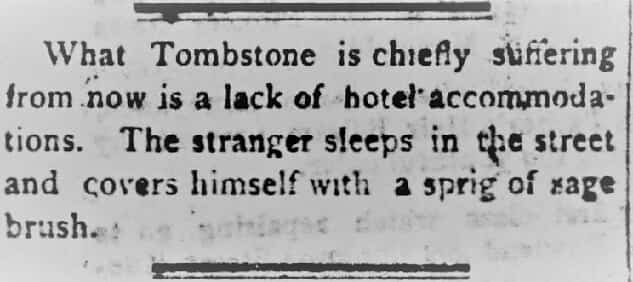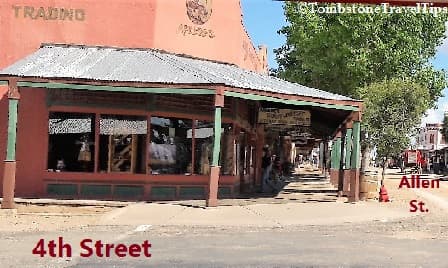The Occidental Hotel in Tombstone Arizona, where you can now have a Magnificent Occidental Virtual Stay! Right here on our webpage by using your imagination along with our historic description. Imagine what it must been like back in those days of the 1880s in Tombstone Arizona. Visiting and staying in this deluxe facility, attending a magnificent event here. Come on in and see!
Destruction Leads to Opportunity
In May 1882 a terrible fire consumed Tombstone’s business district. That included every deluxe, major hotel. Those that were left were Fly’s boarding house and Nellie Cashman’s American Hotel. But they endured some fire damage. The town’s citizens did a lot with bucket brigades that helped save them. Always fearless, and a hard worker, Nellie Cashman herself was out there organizing the brigade, and trading off the buckets down the line!
Some smaller lodgings remained also: the Russ House, and the San Jose House which is still there today. Also the American House, and the Le Van House.
Through most of the rest of that year the town’s coffers suffered as businesses needed to rebuild. Many didn’t have insurance to cover their losses. Some couldn’t recover, and those didn’t rebuild anyway.

From Prescott’s Weekly Arizona Miner of Friday, June 2, 1882
Quoting The Tombstone Epitaph
Entrepreneurs With an Idea!

Joseph Pascholy and Godfrey Tribolet were well known in town. They had already been involved in business. Pascholy was a mining man. He had owned mining interests, plus was a former partner with Nellie Cashman in the Russ House. Tribolet was one of the entrepreneurs for the Golden Eagle Brewery.1
They both realized the need for a First Class hotel. They got together to plan construction of this facility. They prepared to begin in early 1883. They called it the Occidental Hotel.

Occidental Hotel in Tombstone Construction
Right away in 1883 the construction process did begin. The site was the Northeast corner of Allen & 4th Streets.1 It was a major undertaking.
The plans called for adobe construction.2 They thought smarter for fire prevention. It was to have two floors and 40 guest rooms. Also included was a premier style restaurant, a splendid bar area with billiard tables, and card-playing rooms.1

The property had 60 feet of Allen Street frontage, turning the corner on 4th for almost 100 feet of frontage there. When completed, it contained a total of 75 rooms altogether!2
Numerous mentions were made over time that its capacity was for 80 to 100 guests. It was described by a Bisbee newspaper as “one of the best fitted up hotels in Arizona… the stopping place of a number of millionaires who were visitors to Tombstone.”2
The Occidental Hotel in Tombstone Opens
The Grand Opening was on April 7, 1883, you’re invited for a virtual stay! Room rates were 50 cents to $2 per night.1 Find your way to the corner portion of the lot that held the Cosmopolitan Hotel before the 1882 fire.
The bottom floor was mainly dedicated to varied businesses. There was a law office, a newspaper stand and stationary/gift shop, a barber shop/hair salon, a tailor and a livery office.
The most historically famous was the depot office for the Tombstone to Benson Stage Stop. Robert Crouch was the stage line proprietor. He was better known as “Sandy Bob.”3

A Center for Events
The Occidental Hotel had a nice veranda along two sides of its upper level. It had 60 feet of frontage along Allen Street. And then went around the corner onto 4th Street, for a depth of almost 100 feet.2
Many meetings and events were held at the hotel. Other affairs took place outside. The veranda was used as a viewing spot. Women in particular were invited to use that area. The floor of that balcony formed the roof over the boardwalk below. Imagine yourself watching the Independence Day Parade from the Veranda or the Boardwalk!
People from out of town even came to Tombstone to be married. Some were married at the Occidental. Others were wed elsewhere, and held their reception in their party rooms.
Physicians came to town, booking a room for a time. They’d advertise their consultation services while staying in town. Sometimes their consultation had no charge. If they began treatment, there were various charges.
Ownership Changes
In mid October of 1883, Godfrey Tribolet began having legal problems. He even faced prison time and had to hire attorneys. He sold out his interest in the Occidental Hotel.4
In August 1887 Cochise County published tax assessments on properties.

Joseph Pascholy had an assessment of $1000, but along with him was listed a Mr. Sanford. Both were listed for a hotel, which was the Occidental.
A Sudden End – But Slow Death!
In mid September of 1888, an opera troupe from Mexico was staying at the Occidental. One of its members accidentally bumped into an oil lamp. It was knocked over, broke apart and immediately spread flames through the hotel room. Then burst on throughout.3
Everyone evacuated, barely escaping into the street! It was about an hour after midnight, so most had to be rousted from their beds.

The building fully burned down, except for the outer adobe walls. $10,000 of insurance didn’t cover the $25,000 of hotel property loss – never mind the customers’ losses!1
It was never rebuilt. Pascholy eventually sold out to M.D. Scribner. He brought in partner Edward Roberts, and they thought they may rebuild. But instead resold to Douglas Gray, involved with El Paso Smelting Co. and president of Machomich Mercantile Co. But the property sat.1
The adobe walls that survived remained on the lot for over a decade. As time went on, they began to deteriorate even more. Around 1905 the discussion in town was: why is nothing done about the dangerous eyesore of these ruins?3
Then in 1907, a part of one wall collapsed. No one was hurt. The town council finally decided it was time to act. They were about to condemn the property. Douglas Gray, was contacted.1
He planned the project to replace the ruins of the Occidental Hotel. It was a building that could contain a number of shops along the frontage of Allen Street. And then around the corner onto 4th. On April 16, 1907 the ruins were eliminated and a new building was in the works. To be an emporium called The Machomich Mercantile Company. Building designed by Bisbee architect, Frederick C. Hurst. It also held a second story, Maudlin’s Jewelry, and right on the corner – E.R. Flach’s Tombstone Drug Company.1
You can go by to see what’s there today!


References
1 Bailey, L.R. (2004). Too tough to die: The rise, fall and resurrection of a silver camp; 1878 to 1990. Tucson AZ: Westernlore Press.
2 Bisbee Daily Review (1907, Jan. 25). An old historic building is replaced. P. 2. Tombstone Ariz. Jan. 24 Special to Review. Bisbee, AZ. Retrieved from Newspapers.com
3 Bisbee Daily Review (1907, April 17). Old landmark is torn down. P. 4. Tombstone Ariz. April 16 Special to Review. Bisbee, AZ Retrieved from Newspapers.com
4 Weekly Republican (1883, Oct. 18). Territorial twigs. [Epitaph]. P. 2. Phenix, AZ. Retrieved from Newspapers.com

